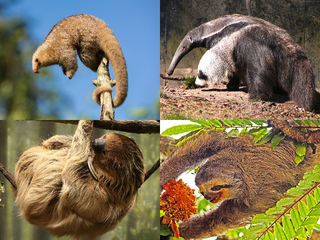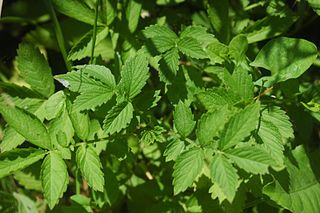
Thomas Say was an American entomologist, conchologist, and herpetologist. His studies of insects and shells, numerous contributions to scientific journals, and scientific expeditions to Florida, Georgia, the Rocky Mountains, Mexico, and elsewhere made him an internationally known naturalist. Say has been called the father of American descriptive entomology and American conchology. He served as librarian for the Academy of Natural Sciences of Philadelphia, curator at the American Philosophical Society, and professor of natural history at the University of Pennsylvania.

The order Pilosa is a clade of xenarthran placental mammals, native to the Americas. It includes the anteaters and sloths. The name comes from the Latin word for "hairy".

Nepenthes pilosa is a tropical pitcher plant endemic to Borneo. It is characterised by a dense indumentum of long yellow-brown hairs. Pitchers have a distinctive hook-shaped appendage on the underside of the lid. The specific epithet derives from the Latin word pilosus, meaning "hairy".

Nepenthes chaniana is a tropical pitcher plant species belonging to the genus Nepenthes. It is characterised by a dense indumentum of long, white hairs. Pitchers are cylindrical and mostly white to yellow in colouration. Nepenthes chaniana belongs to the loosely defined "N. maxima complex", which also includes, among other species, N. boschiana, N. epiphytica, N. eymae, N. faizaliana, N. fusca, N. klossii, N. maxima, N. platychila, N. stenophylla, and N. vogelii.

Bidens pilosa is an annual species of herbaceous flowering plant in the daisy family Asteraceae. Its many common names include hitch hikers, black-jack, beggarticks, farmer’s friends and Spanish needle, but most commonly referred to as cobblers pegs. It is native to the Americas but is widely distributed as an introduced species in other regions worldwide including Eurasia, Africa, Australia, South America and the Pacific Islands. In Chishona, it is called tsine.

Icosta are genus of biting flies in the family of louse flies, Hippoboscidae. There are 52 known species, making it the largest Hippoboscid genus. All species are parasites of birds.

Thecophora is a genus of thick-headed fly from the family Conopidae.

Cymindis is a genus of ground beetle native to the Palearctic, the Near East, and North Africa. It contains the following species:
Bradburia is a North American genus of flowering plants in the family Asteraceae, native to the southern United States.

Genista pilosa, commonly known as hairy greenweed, silkyleaf broom, silkyleaf woadwaxen and creeping broom, is a plant species in the genus Genista. It is 30–45 centimetres (12–18 in) tall and has green coloured stems. It has yellowish coloured flowers which grow in 1-3 pairs. It grows in western and central Europe in poor, dry, sandy, and stony soils.

Luzula pilosa is a species of flowering plant in the rush family Juncaceae with the common name hairy wood-rush. The plant is native to northern Europe and western Asia.

Anchista is a genus of beetles in the family Carabidae, containing the following species:
Cymindis elegans is a ground beetle species in the genus Cymindis, in the subfamily Lebiinae and tribe Lebiini. It is found in Virginia in the United States.
Cymindis cribricollis is a species of ground beetle in the subfamily Harpalinae. It was described by Pierre François Marie Auguste Dejean in 1831.
Cymindis laticollis is a species of ground beetle in the subfamily Harpalinae. It was described by Thomas Say in 1830.
Cymindis ornata is a species of ground beetle in the subfamily Harpalinae. It was described by Fischer Von Waldheim in 1823.

Cymindis platicollis is a species of ground beetle in the subfamily Harpalinae. It was described by Say in 1823.

Eragrostis pilosa is a species of grass in the family Poaceae. It is native to Eurasia and Africa. It may or may not be native to North America. It is widely introduced, and it is a common weed in many areas.

Agrimonia pilosa, also known as hairy agrimony, is a flowering plant in the family Rosaceae. It is distributed primarily over the Korean Peninsula, Japan, China, Siberia, and Eastern Europe.

Philistina is a genus of beetles belonging to the family Scarabaeidae, typically placed in the tribe Phaedimini.














